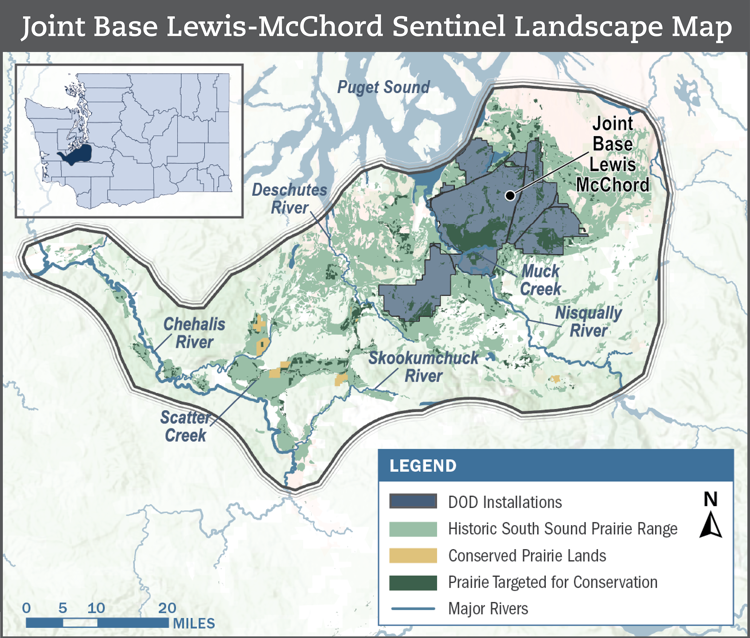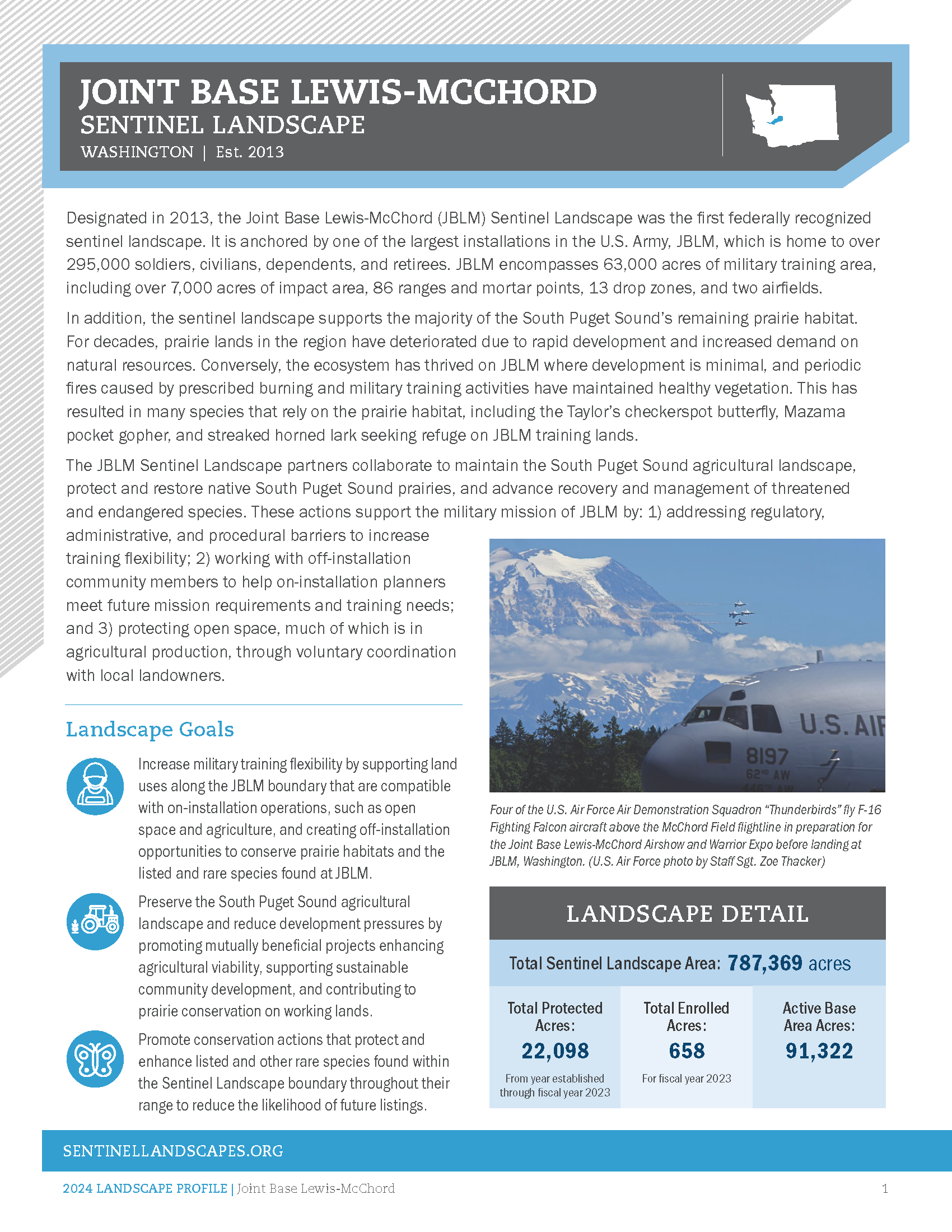Joint Base Lewis McChord Sentinel Landscape
-
Washington
-
Established 2013
About
Designated in 2013, the Joint Base Lewis-McChord (JBLM) Sentinel Landscape was the first federally recognized sentinel landscape. It is anchored by one of the largest installations in the U.S. Army, JBLM, which is home to over 295,000 soldiers, civilians, dependents, and retirees. JBLM encompasses 63,000 acres of military training area, including over 7,000 acres of impact area, 86 ranges and mortar points, 13 drop zones, and two airfields.
In addition, the sentinel landscape supports the majority of the South Puget Sound’s remaining prairie habitat. For decades, prairie lands in the region have deteriorated due to rapid development and increased demand on natural resources. Conversely, the ecosystem has thrived on JBLM where development is minimal, and periodic fires caused by prescribed burning and military training activities have maintained healthy vegetation. This has resulted in many species that rely on the prairie habitat, including the Taylor’s checkerspot butterfly, Mazama pocket gopher, and streaked horned lark seeking refuge on JBLM training lands.
The JBLM Sentinel Landscape partners collaborate to maintain the South Puget Sound agricultural landscape, protect and restore native South Puget Sound prairies, and advance recovery and management of threatened and endangered species. These actions support the military mission of JBLM by: 1) addressing regulatory, administrative, and procedural barriers to increase training flexibility; 2) working with off-installation community members to help on-installation planners meet future mission requirements and training needs; and 3) protecting open space, much of which is in agricultural production, through voluntary coordination with local landowners.

Total Funding by Partner
| Partner | FY2012 | FY2013 | FY2014 | FY2015 | FY2016 | FY2017 | FY2018 | FY2019 | FY2020 | FY2021 | FY2022 | FY2023 |
|---|---|---|---|---|---|---|---|---|---|---|---|---|
| USDA | $0.58M | $0.54M | $0.26M | $4.26M | $0.62M | $7.71M | $5.25M | $0.47M | $0.00M | $2.00M | $0.00M | $0.00M |
| DOW | $0.00M | $0.00M | $0.00M | $0.00M | $0.00M | $0.00M | $0.00M | $0.00M | $0.00M | $0.00M | $0.00M | $0.00M |
| DOI | $1.46M | $1.34M | $0.51M | $5.65M | $7.48M | $2.81M | $0.43M | $2.75M | $0.74M | $6.29M | $1.04M | $8.28M |
| State | $0.57M | $0.39M | $0.28M | $0.43M | $0.37M | $0.16M | $0.63M | $0.00M | $0.00M | $0.00M | $1.45M | $1.81M |
| Local | $0.08M | $0.98M | $1.49M | $1.51M | $0.66M | $0.87M | $0.45M | $0.00M | $0.15M | $0.03M | $0.00M | $0.00M |
| Private | $1.20M | $1.93M | $1.04M | $1.53M | $0.00M | $0.00M | $0.03M | $0.00M | $0.00M | $0.00M | $0.00M | $0.00M |
| DoD | $1.50M | $6.50M | $1.61M | $1.75M | $0.75M | $0.00M | $0.00M | $4.56M | $0.54M | $0.00M | $0.00M | $4.39M |
Total Acres Protected and Enrolled
| Acres Protected (Since Designation) | 22098 |
|---|---|
| Acres Enrolled (During FY23) | 659 |
Our Partners
State Partners
- University of Washington
- Washington Department of Corrections
- Washington Department of Fish and Wildlife
- Washington Department of Natural Resources
- Washington Department of Veterans Affairs
- Washington State Conservation Commission
- Washington State Department of Agriculture
- Washington State University Extension
- Washington Wildlife Recreation and Conservation Office
Resources
-

Joint Base Lewis McChord Sentinel Landscape Profile
Meet the Coordinator

Dan Calvert, PhD
Dan Calvert coordinates the Joint Base Lewis McChord Sentinel Landscape Partnership which brings together partners in working lands, conservation, and the military to advance innovative conservation and community goals. Dan’s career has focused on finding shared values to tackle wicked natural resource management issues. Recognizing the interconnections between human and natural systems and supporting collaborative integrated projects are key values to him. He earned a PhD from Oregon State University and BS from the University of Oregon. In his free time Dan can be found hiking, biking, rafting, skiing, and finding other ways to spend time outside with his wife and two daughters. A self-identified locavore, he spends a lot of time fishing, foraging, gardening, hunting and supporting local food systems in the South Sound region.